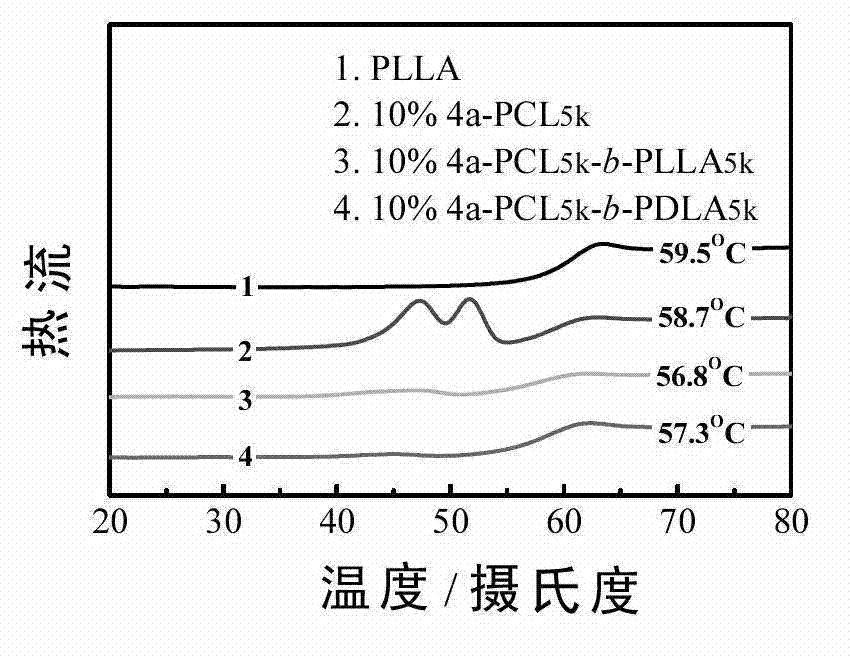Multi-arm block copolymer, preparation method and application of multi-arm block copolymer in improvement of mechanical property of poly-L-lactic acid thereof
The technology of a block copolymer and L-polylactic acid is applied in the application field of improving the mechanical properties of L-polylactic acid, which can solve the problems of poor compatibility and inability to effectively improve the mechanical properties, and achieve good transparency and good dispersion behavior. , the effect of improving mechanical properties
- Summary
- Abstract
- Description
- Claims
- Application Information
AI Technical Summary
Problems solved by technology
Method used
Image
Examples
Embodiment 1
[0046] Embodiment 1: the synthesis of multi-arm block copolymer
[0047] 1) Synthesis of 4a-PCL-b-PDLA
[0048] synthetic circuit such as figure 1 shown. First, the reaction device was evacuated 3 times and protected by argon, and then 8.36g ε-caprolactone, 0.2041g erythritol, 126L of stannous octoate in toluene (0.846mol / L) and 10mL of toluene were placed under argon protection. Add it to the reaction tube, seal it and react at 110°C for two days. Then, the temperature of the reaction tube was lowered to room temperature, and 8.36 g of D-lactide was added into the reaction tube under the protection of argon, and then placed in an oil bath at 110° C. to continue the reaction for 2 to 3 days. After the reaction was completed, it was cooled to room temperature, and the reaction product was repeatedly dissolved / precipitated three times through dichloromethane / methanol (v / v=1 / 10), and finally the product was placed in a vacuum oven at 80°C and vacuum-dried until the quality was...
Embodiment 2
[0055] Embodiment 2: Preparation of multi-arm block copolymer and L-polylactic acid blend (i.e. modified polylactic acid)
[0056] The following takes the blending of the four-arm block copolymer 4a-PCL-b-PDLA prepared in Example 1 and L-PLA as an example. The blending of other multi-arm block copolymers and L-PLA has the same experimental conditions.
[0057] 1) Melt blending
[0058] Weigh 5g of 4a-PCL-b-PDLA and 45g of poly-L-lactic acid (PLLA) (Natureworks, USA, model 2002D) respectively, and process multi-arm block copolymer and poly-L-lactic acid with HAAKE twin-screw internal mixer. Melt blending, the conditions are as follows: the melting temperature of the blend is 170-230° C., the blending speed is 10 rad / min for the first 2 minutes, and 50 rad / min for the last 8 minutes.
[0059] 2) Preparation of splines
[0060] The blend splines were injection molded through a HAAKE MINI JET II with a capacity of 10 cc according to ISO527-2-5A standard. Put the sample obtained...
Embodiment 3
[0063] Embodiment 3: Preparation of multi-arm block copolymer and L-polylactic acid blend (i.e. modified polylactic acid)
[0064] The amount of 4a-PCL-b-PDLA in step 1) of Example 2 was replaced by 2.5g, the amount of L-polylactic acid (PLLA) was replaced by 47.5g, and the other conditions were the same as in Example 2, and a modified polylactic acid sample was prepared. .
PUM
| Property | Measurement | Unit |
|---|---|---|
| elongation at break | aaaaa | aaaaa |
| elongation at break | aaaaa | aaaaa |
Abstract
Description
Claims
Application Information
 Login to View More
Login to View More - R&D
- Intellectual Property
- Life Sciences
- Materials
- Tech Scout
- Unparalleled Data Quality
- Higher Quality Content
- 60% Fewer Hallucinations
Browse by: Latest US Patents, China's latest patents, Technical Efficacy Thesaurus, Application Domain, Technology Topic, Popular Technical Reports.
© 2025 PatSnap. All rights reserved.Legal|Privacy policy|Modern Slavery Act Transparency Statement|Sitemap|About US| Contact US: help@patsnap.com



